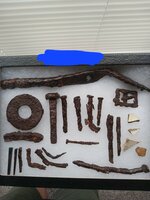My interests are mostly 1800's items (Seminole war items here in Florida etc), which is a lot of Iron item (such as square nails, tools, belt buckles perhaps etc).
So, I would place these items upon returning home into "Metal restore rust removal bath" for 24/48 hours and scrub to get it as close to as pre-rust as possible and cleaned from dirt etc.
Then, I would follow-up with Rust Olem Gloss protective enamel clear spray can. This in time, has shown to NOT be very effective overall sadly.
Any ideas or tips? I have limited space, so electrolysis is essentially out. I saw a product spray can that just seals in the finds "as is" to prevent any additional rusting, but I can't recall the product name.
There is a very famous historical site near here, and they thought humidity and ac would be enough for their finds - less than a year later - and a complete disaster, items just crumbling. I was rather shocked by this, as these are the "professionals" and those who should know better on preservation along with the funding they get and endless Colleges and their studies involved.
Thanks for any info or tips on how you may go about preserving iron and/or other metal finds that don't hold up well once they're out of the ground.
Attached is an image of my finds from about 2 years ago using the above mentioned methods.
So, I would place these items upon returning home into "Metal restore rust removal bath" for 24/48 hours and scrub to get it as close to as pre-rust as possible and cleaned from dirt etc.
Then, I would follow-up with Rust Olem Gloss protective enamel clear spray can. This in time, has shown to NOT be very effective overall sadly.
Any ideas or tips? I have limited space, so electrolysis is essentially out. I saw a product spray can that just seals in the finds "as is" to prevent any additional rusting, but I can't recall the product name.
There is a very famous historical site near here, and they thought humidity and ac would be enough for their finds - less than a year later - and a complete disaster, items just crumbling. I was rather shocked by this, as these are the "professionals" and those who should know better on preservation along with the funding they get and endless Colleges and their studies involved.
Thanks for any info or tips on how you may go about preserving iron and/or other metal finds that don't hold up well once they're out of the ground.
Attached is an image of my finds from about 2 years ago using the above mentioned methods.


